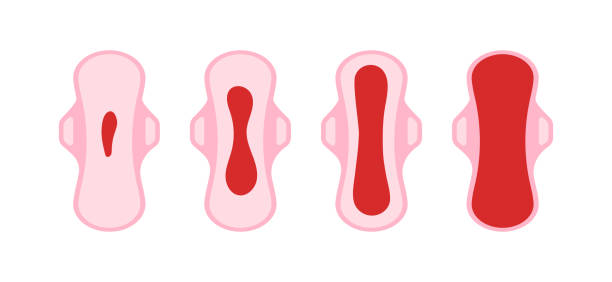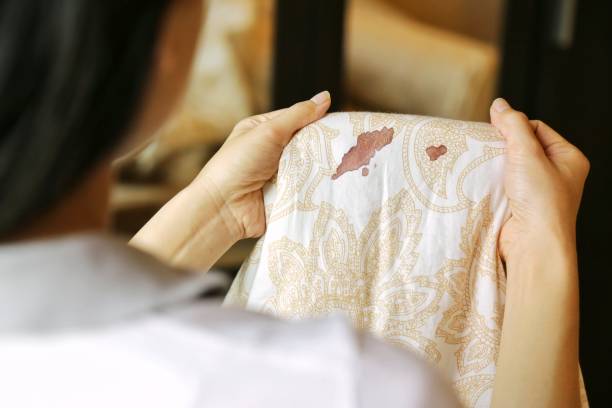Lochia: What's Normal and When to Go to the Doctor for Postpartum Bleeding

Wondering about postpartum bleeding? Discover what's considered normal and when it's time to consult a healthcare professional.
During pregnancy, your body goes through a lot of changes. And such alterations don’t necessarily end when you give birth. You may continue to experience certain symptoms for days or even weeks after giving birth because your body needs time to heal. Postpartum bleeding is one such sign. However, some vaginal bleeding following delivery is typical.
Table of Contents
What is Lochia
The uterine lining thickens during pregnancy as a result of hormones supporting the placenta. The uterus starts to contract and shrink back to its pre-pregnancy size after birth, and the uterine lining starts to shed.
Because it contains the same kind of blood and tissue as menstruation, this shedding (lochia) is not entirely dissimilar. Nevertheless, due to how huge the uterus becomes during pregnancy, lochia occurs on a much greater scale. The discharge after giving birth also lasts somewhat longer than a typical period and undergoes a few modifications before ceasing.
Postpartum bleeding, also known as Lochia is normal. This bleeding after birth can be heavy for the first two days but then subsides.
In the first two days, you will probably require pad changes every 3-4 hours. After that, pad changes will be every 6-8 hours. If you have lochia, it is advised to use sanitary pads and napkins instead of tampons, as tampons increase the risk of infection in your healing vagina and uterus.
What Does Lochia Look Like?
Although every individual is unique, lochia typically progresses in colour and volume in a similar way. Before becoming a white-coloured mucus, it starts out as blood.
Lochia is the term used to describe the vaginal discharge that occurs after giving birth. It is a combination of blood, mucus, and uterine tissue. The discharge, which starts immediately after childbirth, typically continues for about four to eight weeks, during a period known as the postpartum period or puerperium.
Three Stages of Lochia
Lochia progresses through three stages. According to an article published in the Singapore Family Physician,
“After the delivery, the lochia is initially red (lochia rubrum), slowly changing to pale brownish (lochia serosa) and finally to yellowish white (lochia alba).”
- Lochia rubia – is characterised by a red colour due to the presence of blood, fetal membranes, vernix caseosa, and other components. It lasts for one to four days before transitioning to a lighter “spotting” phase.
- Lochia serosa – thinner and turns brownish or pink. It contains serous exudate, erythrocytes, leukocytes, cervical mucus, and microorganisms. This stage persists until around the tenth day after delivery. Prolonged lochia serosa may indicate late postpartum hemorrhaging.
- Lochia alba – the final stage in which the discharge becomes whitish or yellowish-white. It occurs from the second to the third to sixth weeks after delivery and consists of leukocytes, epithelial cells, cholesterol, fat, mucus, and microorganisms

Image Source: iStock
Lochia Duration: How Long Do You Bleed After Birth?
Lochia will stop about one month after delivery. For some women, it can last for 6 to 8 weeks.
Lochia rubria should begin to change colour about two days postpartum.
If you are not breastfeeding, you can expect your period to resume after 6 to 8 weeks. If you are breastfeeding, your period will probably resume only after you stop breastfeeding.
Lochia After C-Section
Will you have postpartum bleeding after having a C-section?
Experts say yes, but it’s not the same with a vaginal delivery. Why? Because after you delivered your baby through cesarean, your doctors manually clean the uterus out with a swab to ensure that they have removed all of the placenta and membranes. This process does not happen in vaginal deliveries, which is why C-section mums will have less lochia.
Can I Have Sex If I Have Postpartum Bleeding
It is generally recommended to wait for a period of four to six weeks after delivery before engaging in sexual activity if you still have postpartum bleeding. This waiting period allows your body time to heal from childbirth and reduces the risk of complications.
Postpartum bleeding can be accompanied by vaginal soreness, fatigue, vaginal dryness, pain, and low sexual desire, which may affect your comfort during intercourse. If you had a vaginal tear that required surgical repair, you might need to wait even longer before resuming sexual activity.
It’s important to communicate with your healthcare provider about your specific situation and follow their guidance regarding the appropriate timing for sexual intercourse after childbirth.
Lochia and First Period – How to Tell the Difference Between the Two
After giving birth, it is important to understand the differences between lochia and the first period to ensure proper postpartum care.
Lochia has a stale, musty odor similar to menstrual period discharge and can last several weeks. Lochia follows a progression in color and volume: it starts as dark or bright red blood, then transitions to a pinkish brown color, and finally changes to a creamy, yellowish-white discharge.
On the other hand, the first menstrual period after giving birth usually occurs several weeks or months after delivery and can vary in duration and intensity.
While both lochia and the first period may have a distinct smell and begin as a dark red, heavy discharge, the key difference is the duration. Lochia typically lasts about six weeks, while a typical period lasts about one week.
Why You Might Experience More Bleeding

Image source: iStock
After delivery, bleeding ought to lessen for a few weeks before ceasing entirely. However, a few factors, such as the following, can momentarily improve blood flow:
- rising early in the morning
- breastfeed (your body produces the hormone oxytocin while you nurse, which stimulates uterine contractions and accelerates healing)
- exercising
- stooping or straining when urinating or pooping
What to do if you’re bleeding
It’s likely that the initial bleeding will be so severe that you’ll need to wear a hospital pad. When you are discharged, the nurse might offer you some of these extra-absorbent pads.
You can switch to a regular menstruation pad once the bleeding decreases.
To avoid infection, make sure to replace your pads frequently. Tampons should not be used unless your doctor gives the all-clear. You can switch to a panty liner once the bleeding is minimal enough or you’re only seeing discharge.
Bleeding After Giving Birth: What Else Causes It?

Image source: iStock
There are a number of potential causes for irregular bleeding after birth. If the blood isn’t truly coming from your uterus, you may have a vaginal tear, a bladder haemorrhage, or even an unidentified bleeding problem.
Additionally, there can be a problem with how your uterus is generally contracting.
Mums are said to have uterine atony when they have copious lochia and the uterine fundus is not solid. This can happen if the uterus isn’t contracting enough, if the placenta or membranes are still inside the uterus, or if there is another anatomical issue, such as a fibroid inside the uterine lining, that prevents the uterus from contracting.
In these circumstances, you should probably see your doctor, who will be able to massage your uterus, expel any clots, and—if necessary—prescribe medicine to assist your uterus contract.
ALSO READ:
Postpartum Checkup: What to Expect on Your First Doctor’s Appointment After Giving Birth
Postpartum Sex: What You Need to Know About Sex After Giving Birth
When Can I Travel After Giving Birth? Mums, Here’s Your Guide on Postpartum Travel
How To Stop Postpartum Bleeding Faster: Home Treatment For Lochia
After childbirth, recovery takes many weeks. While you can’t exactly stop postpartum bleeding completely, there are some things you can do to manage it. Following are some recommendations for managing postpartum bleeding:
-
Rest and Take It Easy
Give your body the time it needs to heal and recover by getting plenty of rest and avoiding strenuous activities.
-
Use Appropriate Absorbent Products
Choose postpartum pads or maternity pads to manage the bleeding effectively.
-
Practice Good Hygiene
Keep the perineal area clean and dry, and change pads frequently to prevent infection.
-
Avoid Tampons and Sexual Intercourse
Refrain from using tampons or engaging in sexual intercourse until your healthcare provider gives you the green light.
-
Consult Your Healthcare Provider
If you have concerns about the amount or duration of postpartum bleeding, it’s important to reach out to your healthcare provider for guidance and evaluation.
Allow your body to heal. Even while it might sound wonderful to get back to your regular routine, doing so can keep you from mending. Additionally, it can make your bleeding worse or recur.
When To Call The Doctor

Image Source: iStock
Normally, Lochia doesn’t lead to problems. The amount of bloody discharge should naturally decrease till it is finished. You should keep an eye out for indications of abnormal bleeding or discharge, though.
In the weeks following giving birth, if you develop any of the following symptoms, call your doctor right away:
-
Vaginal discharge that is green.
-
Your lochia is still bright red four days after your baby’s birth.
-
An unpleasant odour (worse smelling than your usual period).
-
Abnormally heavy bleeding or discharge (soaking a pad every hour).
-
Excessive clotting or large, golf-ball-sized clots.
-
Chills, a fever, or flu-like symptoms.
-
Pain or swelling in the vicinity of your vagina.
-
Your vision is getting blurred.
-
Weakness, unsteadiness or a fainting feeling.
-
Prolonged cramping or pain in the pelvis.
Updates by Matt Doctor
Here at theAsianparent Singapore, it’s important for us to give information that is correct, significant, and timely. But this doesn’t serve as an alternative for medical advice or medical treatment. theAsianparent Singapore is not responsible for those that would choose to drink medicines based on information from our website. If you have any doubts, we recommend consulting your doctor for clearer information.
- Must see: Mum's hilarious postpartum photo goes viral
- Joanne Peh has THIS Advice For New Mums Struggling With Their Postpartum Bodies!
- Melissa Faith Yeo Claims Andie Chen Accused Her of Cheating to Get Pity Votes for Star Awards
- I Try Tracy Lee's Hack for Egg Tarts and It's So Easy That Even Kids Can Make it